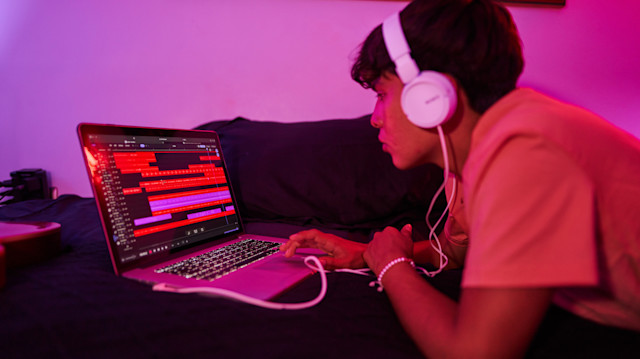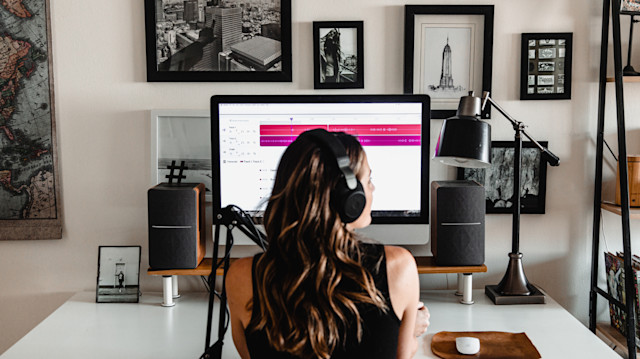How To Change Speed or Pitch of Audio Online
Are you looking for a way to speed up or slow down audio? With Soundtrap's online DAW, you can easily change the speed and pitch of a song directly online!

Published: April 19, 2023
Are you looking for a way to speed up or slow down audio? With Soundtrap's online DAW, you can easily change the speed and pitch of a song directly online! Whether you want to make a sped-up or slowed-down remix of another song with BPM (beats per minute), change the pitch of a song, or both, this blog post will show you how to do it.
We'll discuss the differences between song pitch and song speed, the popularity of sped-up songs on social media, and how to alter this using BPM, pitch, and time stretch.
Change song pitch vs. song speed
It is important to understand the differences between pitch and speed/tempo to know what you are doing to the audio file you are working with.
Song Pitch
Song pitch refers to how high or low a sound is, determined by its frequency. Think of it as a piano keyboard, where the lowest frequency keys are on the left and the highest on the right. The same applies to any audio recordings. The higher the pitch, the higher the frequency.
When changing a song's pitch, you are adjusting its overall tonal range. This can be done using Soundtrap's pitch changer. It allows you to increase or decrease the frequency of any given note or instrument within a track, or the entire audio file if you’re remixing an existing song.
Song Speed or BPM
On the other hand, song speed is simply how fast or slow a track plays back with respect to time. It does not affect the overall tone like changing its pitch does; instead, it controls how quickly each beat passes by within a given measure (BPM).
You can adjust the speed of a track, note, or song using Soundtrap's BPM setting (beats per minute), which lets you set an exact tempo for your track and adjust it accordingly up or down depending on how fast or slow you want the audio to play.
Most sped-up or slowed-down songs you hear use a combination of speed and pitch. For example, if you want your song to play faster, AND have that chipmunk effect on the vocals that you hear in remixes. You should try increasing both the BPM and the pitch of the audio.
How to speed up/slow down your tracks | Ask The Producer w/ Adam Siana
The popularity of sped-up songs on social media
The popularity of speed-up songs on social media has been rapidly growing in recent years. On platforms such as TikTok, Instagram, and YouTube, sped-up remixes of popular tracks are constantly being shared and viewed by millions of people around the world.
Speed-remixed songs by social media users are a way of tapping into the recognition of known songs and at the same time creating new and unique content for their followers. The easy access to audio editing tools online, like Soundtrap, has probably also played a big role in the surging trend.
By speeding up or slowing down a song, a creator can quickly make a new version that stands out from the original track. This allows users to express their creativity while also creating something that is likely to be shared and enjoyed by others.
Sped-up remixes have become particularly popular on TikTok, where they are often used in dance challenges or lip-sync videos. Users find these clips entertaining and engaging due to their fast pace and high energy levels.
As a result, many of these remixed tracks have gone viral, receiving millions of views and likes within hours of being posted online. It has even made old classics from the 70s and 80s climb the charts and become hit songs again to a whole new generation.
In addition to TikTok, Instagram has also become a platform for sharing speed remixes; however, the tone here tends to be more minimalistic than on other sites. For example, some musicians post slowed-down covers of classic tracks on Instagram Stories or IGTV with effects added to the song (such as reverb).
Copyright laws for remixing songs
It should be noted that remixing a commercial song, by speeding up or slowing down the master file, and releasing it publicly without the consent of the rightsholders is considered copyright infringement. If you are planning to release a remix of a song on social media, you will need to get permission from both the rightsholders and the owner of the master recording. Read more about copyright laws in music here.

If you plan to release a remix of a song, you will need to get permission from the rightsholders.
How to speed up songs
Slowing down a song or instrument works in the same way as speeding up your audio, but instead of increasing the BPM, you should lower the BPM to a tempo of your liking.
Once your song is playing at a slower BPM, you can lower the pitch of the song as well. This will add a dark, slurry effect to the instruments and vocals. This method was used to create the Chopped and Screwed sub-genre of hip-hop in the American South during the 90s. It’s still very popular in modern Trap music and Phonk.
Decrease the pitch of the audio by right-clicking the region and choosing a negative pitch. Don’t go too far here either. -1 or -2 notes should be more than enough.
Change the tempo of the song by BPM
When it comes to changing the tempo of a song, one of the most popular and effective ways to do so is through BPM (Beats Per Minute). BPM is a measure of the speed or tempo of a song, and it can be adjusted with Soundtrap's DAW. As you adjust the BPM, you also change the overall speed and feel of the song.
Change the pitch of a certain region
If you’re creating a whole new song from scratch, and you have the stems to each element of the song in your Soundtrap project, you can choose to only change the pitch of one or more instruments. So rather than increasing or decreasing the pitch of the entire song, you can change the pitch of just your vocals or your synth. Just right-click on the audio region of your choice and pick a pitch change.
Change the pitch of the whole song project
If you would like to change the pitch of the whole song. It’s easiest to just export your project to a wav file and then re-import it into Soundtrap. This will give a one track project of the whole song and allows you to change the pitch, and speed for that matter, of all the instruments and vocals simultaneously.
If you’re remixing an existing song, you can just import the file right away into Soundtrap and start manipulating both pitch and speed.

If you’re remixing an existing song, you can just import the file right away into Soundtrap.
Make a sped-up or slowed-down remix of another song
If you’re remixing an existing song, you can just import the file right away into Soundtrap and start manipulating both pitch and speed using the same tools we’ve explained above.
Remember to obtain remixing licenses from the rightsholders before you release your creation to the world
Change the speed & pitch using time stretch
Soundtrap also allows you to change the tempo of the song using time stretch. This gives you more flexibility than the BPM setting because you can stretch or contract the audio file freely without adjusting the tempo setting. Read more about using time stretch here.
After you’ve adjusted the song speed with time stretch, right-click the same audio region and adjust the pitch to your liking. There you go, your speed remix is done and ready!
In conclusion, Soundtrap makes it easy for anyone to change the speed and pitch of a song directly online with minimal effort. It is an invaluable tool for those looking to make creative remixes out of popular songs or create new music that’s sped up or slowed down. Try it out for yourself by signing up today!
Get started with Soundtrap today!